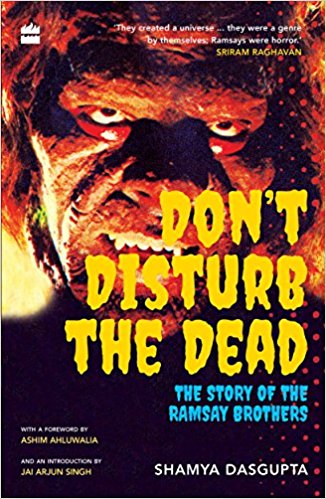 By SHAMYA DASGUPTA (HarperCollins; 2017)
By SHAMYA DASGUPTA (HarperCollins; 2017)
It’s no exaggeration to say that for Indian film fans the Ramsay Brothers are horror. Having gotten their start in the 1970s, the Ramsays created a string of horror films that are, frankly, extremely silly by modern standards yet were quite iconic with audiences in their native land. DON’T DISTURB THE DEAD is the first-ever book about the Ramsays, and must be counted as the premiere print resource on the subject. The text has its share of problems, but on balance it’s a solid and informative read.
DON’T DISTURB THE DEAD is the first-ever book about the Ramsays and must be counted as the premiere print resource on the subject.
Author Shamya Dasgupta deftly guides us through the Ramsay saga, involving the family patriarch Fatehchand Uttamchand Ramsinghani, or F.U. Ramsay, and his sons Kumar, Gangu, Tulsi, Arjun, Keshu, Shyam and Kiran. F.U. owned a radio business in his earlier years, and dabbled unsuccessfully in filmmaking. The turning point came in 1970, with the F.U. produced EK NANHI MUNNI LADKI THI, an unsuccessful thriller containing a shock sequence that according to Tulsi and Shyam really brought audiences to life whenever the film played. As Shyam concluded, “In the safety of the theater, with friends and family members around them, people liked the thrill of being frightened. We thought it was worth exploring.”
“In the safety of the theater, with friends and family members around them, people liked the thrill of being frightened.”
F.U. agreed to assist in this “exploration,” putting his seven sons through filmmaking boot camp and assigning each of them a particular discipline—Tulsi and Shyam were taught direction, Kumar learned screenwriting, Gangu and Keshu were trained as cameramen, Kiran sound recording and Arjun editing—that they largely retained in all the Ramsay films. Their first notable production was DO GAZ ZAMEEN KE NEECHE, billed as “India’s First Horror Movie,” which set the tone for what was to come: a gothic stew of graveyards, zombies and curses, marked by cut-rate production values and lensed in the scenic Bombay province of Mahabaleshwar (a particularly desirable location due primarily to the fact that it contained not one but two graveyards), where quite a few subsequent Ramsay productions were shot.
Their first notable production was DO GAZ ZAMEEN KE NEECHE, billed as “India’s First Horror Movie,” which set the tone for what was to come: a gothic stew of graveyards, zombies and curses, marked by cut-rate production values…
DO GAZ ZAMEEN KE NEECHE Full Movie
Those productions would come to include DARAWAZA, SABOOT, GUEST HOUSE, DAHSHAT, SANNATA, HOTEL, PURANA MANDIR, 3D SAAMRI and VEERANA. By the nineties, alas, moviegoers grew tired of the formulaic plotlines and cheap veneers of the Ramsay films, and the family’s fortunes, already crippled by the mid-1980s defection of Keshu (who went on to make movies independently of the family, and died in 2010), declined. In the mid-nineties they migrated to the small screen with ZEE HORROR SHOW, which kicked off a new, though not necessarily better, television based career path.
ZEE HORROR SHOW Episode “The Door”
This book offers an admirably thorough guide to all things Ramsay. Included are personality profiles of each of the brothers and interviews with several of their stock actors, including Ajay Agarwal, the “Great Ramsay Monster Man,” and Aarti Gupta, the “No. 1 Ramsay heroine,” as well as Christopher Tucker, the British make-up whiz who designed many of the masks and prosthetics used by the Ramsays.
Shamya Dasgupta, however, may be a bit too thorough in his personality profiles. I’m not sure we need the lengthy reminiscence by Keshu’s widow about their courtship (which frankly isn’t nearly as interesting as the author seems to think). While I’m on the subject of authorial missteps, I should add that a working knowledge of Hindi cinema is a requisite for prospective readers, as the book is positively steeped in it, and offers little explanation for those who aren’t. In other words, if you’re unfamiliar with Amitabh Bachchan, Mithun Chakraborty, the Filmfare Awards or the Indian movie ratings system then you’re going to be a mite confused.
See Also: Bollywood
